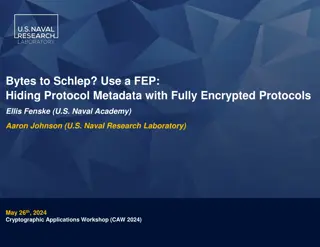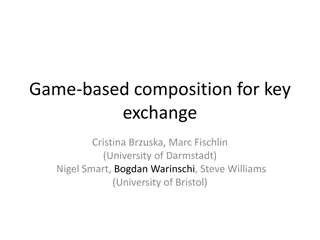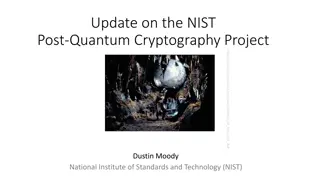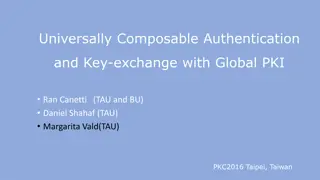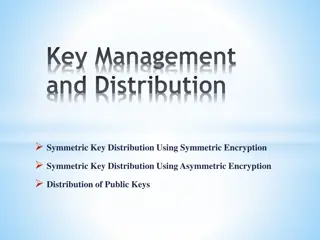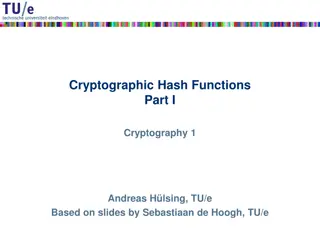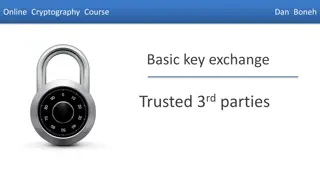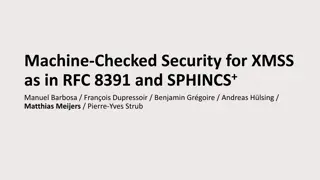Understanding Cryptographic Protocols and Key Exchange
This content delves into the world of cryptographic protocols, discussing the importance of security measures such as symmetric cryptography, hash functions, and public-key cryptography. It explores the field's various studies, goals, Diffie-Hellman key exchange, and the significance of key size in ensuring secure communication. Dive into the complexities of cryptographic algorithms and the challenges faced in implementing secure key exchange mechanisms in modern communication systems.
Download Presentation

Please find below an Image/Link to download the presentation.
The content on the website is provided AS IS for your information and personal use only. It may not be sold, licensed, or shared on other websites without obtaining consent from the author. Download presentation by click this link. If you encounter any issues during the download, it is possible that the publisher has removed the file from their server.
E N D
Presentation Transcript
David Adrian, Karthikeyan Bhargavan, etc. Presented by Eunyoung Cho
What does security depend on? These objects embed some cryptography. Protocols includes various kinds of primitives. Symmetric cryptography (AES, ) Hash functions (md5, SHA-1, SHA-3, ) Public-key cryptography (RSA, DSA,...)
Various fields of study Cryptographic protocols Implementation of cryptographic software Auditing implementations Scrutiny of cryptographic primitives Oppositely Breaking a public-key cryptographic primitive by solving a mathematical problem
Goals Breaking a public-key cryptographic primitive Usual measurement unit is public key size When key size grows The mathematical problem is harder to solve. The hardness of the mathematical problem depends on the algorithm used. Legitimate computation is less efficient. Acompromise is to be found when deploying public-key cryptography.
Diffie-Hellman 1976 Short review of Diffie-Hellman using a Video clip (< 3min) Public Parameters p : a prime g : < p group generator (often 2 or 5)
DHKE is extremely common on the internet Protocol support for mod p Diffie-Hellman in Spring 2015 was
What is key exchange useful for? Key exchange happens at the beginning of a secure communication. Alice and Bob both gained knowledge of ???and used it for deriving a session key for encrypting the remainder of communication (with AES). An eavesdropper cannot derive ???from ??and ??unless he solves the discrete logarithm problem (DLP)GF(p). Attackers need to solve ?? a for one session key Number field sieve to solve DLP With x = p
The Number Field Sieve Goal : given , find x
Key Size Key exchange uses Diffie-Hellan : DHE or ECDHE For DHE, primes are Internet-wide scan of HTTPS servers using Zmap 14.3M hosts, 24% support DHE 70,000 distinct groups (p,g) Composite-order groups with short exponents 4800 groups where (p-1)/2 was not prime Got prime factors for 750 groups on 40K connection Some servers used short exponents : 128/160 bits Used Pohlig-Hellman to compute Full secret exponent for 159 servers Partial exponent for 460 servers
Key Size Small-sized safe primes Of the Top 1M sites that support DHE in HTTPS 84% (2.9M) servers uses a 1024-bit or smaller group With 94% of these using one of five groups 2.6%(90K) servers use 768-bit primes. 0.0008% (2.6K) servers use 512-bit primes
Key Size : what about 512-bit keys? TLS 1.0 supported weakened ciphers to comply with export regulations in 1990s. DHE_EXPORT groups limited to 512 bits key. Computation is easy. This is never the preferred choice in a TLS connection However . but only when client asks for it.
DHE_EXPORT DHE_EXPORT handshake looks just like DHE Server uses same long-term signing key for both Difference is prime-size, which clients don t check Opens the way to a downgrade attack
Logjam Active TLS MITM downgrade attack to 512 bit export DHE Protocol flaw : Server does not sign chosen cipher suite.
Logjam Downgrade to DHE_EXPORT A man-in-the-middle attacker can Impersonate any server that supports DHE_EXPORT At any client that accept 512-bit DHE groups Export cipher suites in TLS TLS_RSA_EXPORT_WITH_RC4_40_MD5 TLS_RSA_EXPORT_WITH_RC2_CBC_40_MD5 TLS_RSA_EXPORT_WITH_DES40_CSC_SHA TLS_DH_RSA_EXPORT_WITH_DES40_CSC_SHA TLS_DHE_DSS_EXPORT_WITH_DES40_CSC_SHA TLS_DHE_RSA_EXPORT_WITH_DES40_CSC_SHA ..
Computing 512-bit discrete logs Carried out precomputation for Apache, mod_ssl primes. After 1 week precomputation, Per-connection descent computation: 30-150 sec Median individual log time is 70 sec
Most hosts use the same parameters Parameters hard-coded in implementations or built into standards. 92% of DHE_EXPORT host choose one of two 512-bit primes. Top ten primes accounted for 99% of DHE_EXPORT-tolerant hosts.
Logjam Exploiting False Start Some web browsers start sending data too early To optimize TLS performance for PFS ciphersuites No need to wait up to 150 sec for DLP Logjam can capture this early application data and compute DLP at leisure to read password/cookies ..
Cost estimates for bigger groups For DHE_EXPORT connections Connections between Chrome/Firefox/IE and 8.4% of websites can be broken offline( no forward secrecy) For regular DHE, they need to break bigger groups For academics, probably need to algorithmic improvements For governments, 768 bits is definitely reachable.
Decrypt the VPN traffic? IKE key Exchange for VPNs/IPsec IKE chooses Diffie-Hellman parameters from standardized set.
Decrypt the VPN traffic? Find pre-Shared Key Locate complete paired collect Locate both IKE and ESP traffic Have collection sites do surveys for the IP s Find better quality collect with rich metadata Refer to NSA VPN Attack Orchestration in the paper
Decrypt the VPN traffic? It seems plausible! A 1024-bit DH break is a parsimonious explanation for NSA s large-scale passive decryption of VPN traffic. A well-designed implant would have fewer requirements.
Impact of breaking bigger groups IKEv1, IKEv2, SSH all use 768-bit/1024-bit groups 6% of IKEv2 servers use Oakley 1 (768-bits) 64% of IKEv2 servers use Oakley 2 (1024-bits) 26% of SSH servers use Oakley 2 (1024-bits) 13% of HTTPS servers use 1024-bit Apache group
Parameter reuse for 1024-bit Diffie-Hellman Precomputation for a single 1024-bit prime allows passive decryption of connections to 66% of VPN servers and 26% of SSH servers in Oakley Group 2 Precomputation for a second common 1024-bit prime allows passive decryption for 18% of top 1M HTTPS domains in Apache 2.2
Solutions Logjam Mitigation Security updates to major TLS libraries, web browsers, websites, mail servers Disable 512-bit, then 768-bit, then 1024 bit They recommend 2048-bit safe primes Major browsers have raised minimum DH lengths: IE, Chrome, Firefox to 1024 bits Safari to 768 bits TLS 1.3 draft anti-downgrade mechanism
Solutions 1024-bit discrete log within range for governments Parameter reues allows wide-scale passive decryption Mitigations Move to elliptic curve cryptography If ECC is not an option, use 2048 bit primes. If 2048 bit primes are not an options, generate a fresh 1024 bit prime.
A new protocol: TLS 1.3 Stronger key exchanges, fewer options DCDHE and DHE by default, no RSA key transport Fixed DH groups (>2047 bits) and EC curves (>255 bits) Only AEAD ciphers(AES-GCM), no CBC, no RC4 Signatures, session keys bound to handshake parameters Server signature covers ciphersuite (preventing Logjam) Faster Lower latency with 1 round-trip
Questions Logjam is an active TLS MIMT ( ) Attack to 512-bit DHE ( )- grade cipher suites. The number field sieve algorithm for discrete log consists of a precomputation stage and an individual log computation stage. What is four steps in the stages? With a decent implementation, the computation takes an average of 70 sec. How can attacker work around this delay?










